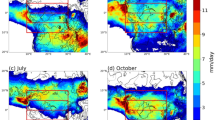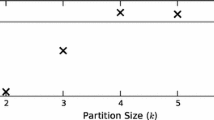Summary
Three-dimensional numerical model simulations of a mesoscale convective system are performed to evaluate the sensitivity of the simulations to differences in the convective trigger function. The Penn State/NCAR mesoscale model with the Kain-Fritsch convective parameterization scheme is used as the modeling system for the study. All simulations are performed on the June 10–11, 1985 squall line from the OK PRE-STORM field experiment. Individual simulations differ only in their specification of the trigger function within the Kain-Fritsch scheme. Comparison of results from 12 hour simulations indicates that the position, timing, and intensity of convective activity and mesoscale features vary substantially as a function of the trigger function formulation. The results suggest that the convective trigger function is an integral part of the overall convective parameterization problem, and that great care must be exercised is designing realistic trigger function formulations, especially as model resolutions approach the scale of individual convective clouds.
Similar content being viewed by others
References
Anthes, R. A., 1977: A cumulus parameterization scheme utilizing a one-dimensional cloud model.Mon. Wea. Rev.,105, 270–286.
Arakawa, A., Schubert, W. H., 1974: Interaction of a cumulus cloud ensemble with the large-scale environment, Part I.J. Atmos. Sci.,31, 674–701.
Anthes, R. A., Hsie, E.-Y., Kuo, Y. H., 1987:Description of the Penn State/NCAR Mesoscale Model Version 4 (MM4), NCAR/TN-282+STR, National Center for Atmospheric Research, Boulder, CO, 66 pp.
Bean, B. R., Emmanuel, C. B., Gilmer, R. O., McGavin, R. E., 1975: The spatial and temporal variations of the turbulent fluxes of heat, momentum and water vapor over Lake Ontario.J. Phys. Oceanogr.,5, 532–540.
Bean, B. R., Glimer, R., Grossman, R. L., McGavin, R., 1972: An analysis of airborne measurements of vertical water vapor flux during BOMEX.J. Atmos. Sci.,29, 860–869.
Blackadar, A. K., 1979: High resolution models of the planetary boundary layer. In: Pfafflin, J., Ziegler, E. (eds.)Advances in Environmental Science and Engineering, 1, No. 1. New York: Gordon and Briech Sci. Publ., 50–85.
Chen, C., Orville, H. D., 1981: Effects of mesoscale convergence on cloud convection.J. Appl. Meteor.,19, 256–274.
Cunning, J. B., 1986: The Oklahoma-Kansas preliminary regional experiment for STORM-Central.Bull. Amer. Soc.,67, 1478–1486.
Dudhia, J., 1989: Numerical study of convection observed during the winter monsoon experiment using a mesoscale tuo-dimensional model.J. Atmos. Sci.,46, 3077–3107.
Frank, W. M., Cohen, C., 1985: Properties of tropical cloud ensembles estimated using a cloud model and an observed updraft population.J. Atmos. Sci.,42, 1911–1928.
Fritsch, J. M., Chappell, C. F., 1980: Numerical prediction of convectively driven mesoscale pressure systems. Part I: Convective parameterization.J. Atmos. Sci.,37, 1722–1733.
Fritsch, J. M., Chappell, C. F., Hoxit, L. R., 1976: The use of large-scale budgets for convective parameterization.Mon. Wea. Rev.,104, 1408–1418.
Grell, G. A., 1992: Prognostic evaluation of assumptions used by cumulus parameterizations.Mon. Wea. Rev. (in press).
Johnson, R. H., Hamilton, P. J., 1988: The relationship of surface pressure features to the precipitation and air flow structure of an intense midlatitude squall line.Mon. Wea. Rev.,116, 1444–1472.
Kain, J. S., Fritsch, J. M., 1990: A one-dimensional entraining/detraining plume model and its application in convective parameterization.J. Atmos. Sci.,47, 2784–2802.
Kreitzberg, C. W., Perkey, D. J., 1976: Release of potential instability: Part I. A sequential plume model within a hydrostatic primitive equation model.J. Atmos. Sci.,33, 456–475.
Kuo, H. L., 1974: Further studies of the parameterization of the influence cumulus convection on large scale flow.J. Atmos. Sci.,31, 1232–1240.
Rutledge, S. A., Houze, R. A., Biggerstaff, M. I., Matejka, T., 1988: The Oklahoma-Kansas convection system of 10–11 June 1985: Precipitation structure and single-doppler radar analysis.Mon. Wea. Rev.,116, 1409–1430.
Stull, R. B., 1988:An Introduction to Boundary Layer Meteorology, Dordrecht: Kluwer Academic Publishers, 666 pp.
Young, G., Fritsch, J. M. 1989: A proposal for general convections in analysis of mesoscale boundaries.Bull. Amer. Meteor. Soc.,70, 1412–1421.
Zhang, D.-L., Anthes, R. A., 1982: A high resolution model of the planetary boundary layer-sensitivity tests and comparisons with SESAME-79 data.J. Appl. Meteor.,21, 1594–1609.
Zhang, D.-L., Chang, H.-R., Seaman, N. L., Warner, T. T., Fritsch, J. M., 1986: A two-way interactive nesting procedure with variable terrain resolution.Mon. Wea. Rev.,114, 1330–1339.
Zhang, D.-L., Fritsch, J. M., 1986: Numerical simulation of the meso-β scale structure and evolution of the 1977 Johnstown flood. Part I: Model description and verification.J. Atmos. Sci.,43, 1913–1943.
Zhang, D.-L., 1989: The effect of parameterized ice microphysics on the simulation of vortex circulation with a mesoscale hydrostatic model.Tellus,41A, 132–147.
Zhang, D.-L., Gao, K., 1989: Numerical simulation of an intense squall line during 10–11 June 1985 PRE-STORM. Part II: Rear inflow, surface pressure perturbations, and stratiform precipitation.Mon. Wea. Rev.,117, 2067–2094.
Zhang, D.-L., Gao, K., Parsons, D. B., 1989: Numerical simulation of an intense squall line during 10–11 June 1985 PRE-STORM. Part I: Model verification.Mon. Wea. Rev.,117, 960–994.
Author information
Authors and Affiliations
Additional information
With 7 Figures
Rights and permissions
About this article
Cite this article
Kain, J.S., Fritsch, J.M. The role of the convective “trigger function” in numerical forecasts of mesoscale convective systems. Meteorl. Atmos. Phys. 49, 93–106 (1992). https://doi.org/10.1007/BF01025402
Received:
Revised:
Issue Date:
DOI: https://doi.org/10.1007/BF01025402




